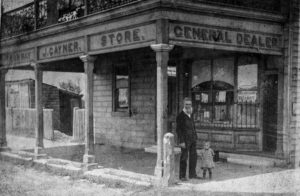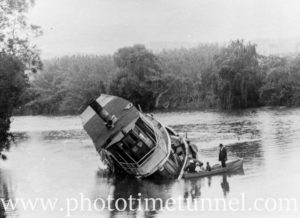This article was written by the late Ken Magor, probably in the 1960s, as part of a larger piece he titled “Destination Newcastle”. Ken had a deep fascination for buses (and trams, trains and fire engines!) and a love of obscure detail. I’ve edited the article as lightly as possible.
First motor bus records show that a Mr Gee commenced a service from the old Hamilton Council Chambers, Beaumont Street, via Tudor Street and Hunter Street to a spot near the Newcastle Hospital in 1918.
George King operated the first motor bus to Tighes Hill and had four buses named “Delunga”, “Denoga”, “Denega” and “She’ll Do Us”. The drivers were clothed in dust coats, cloth caps and leather gloves. After pioneerlng this route it was extended to Mayfield East. The original motors that drove the buses were all Jefferys.
The 1920s saw a large private bus system forming and a varied type of vehicle operating over routes which spread like a spider’s web. In the early 1930s the government gradually took over the various routes and buses, many owners and drivers being employed by the department. The private operators have now become stabilised and with few exceptions on minor routes are only licensed to operate “Industrial Services” and special hirings for picnics etc. It can be noted here that the word “Chartered” now appears on the destination roll in lieu of “Special” on these occasions. The standard of their vehicles is governed by an Inspector of the Department of Road Transport.
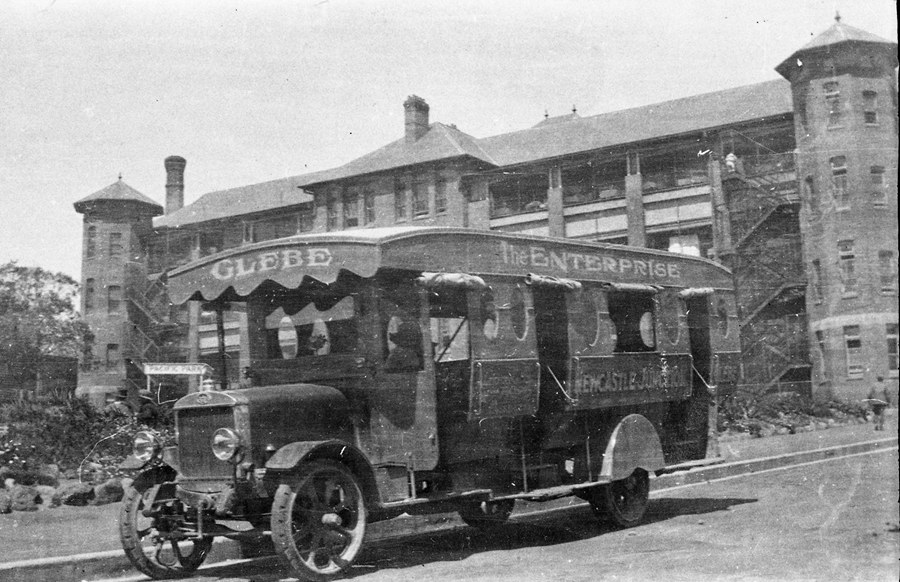
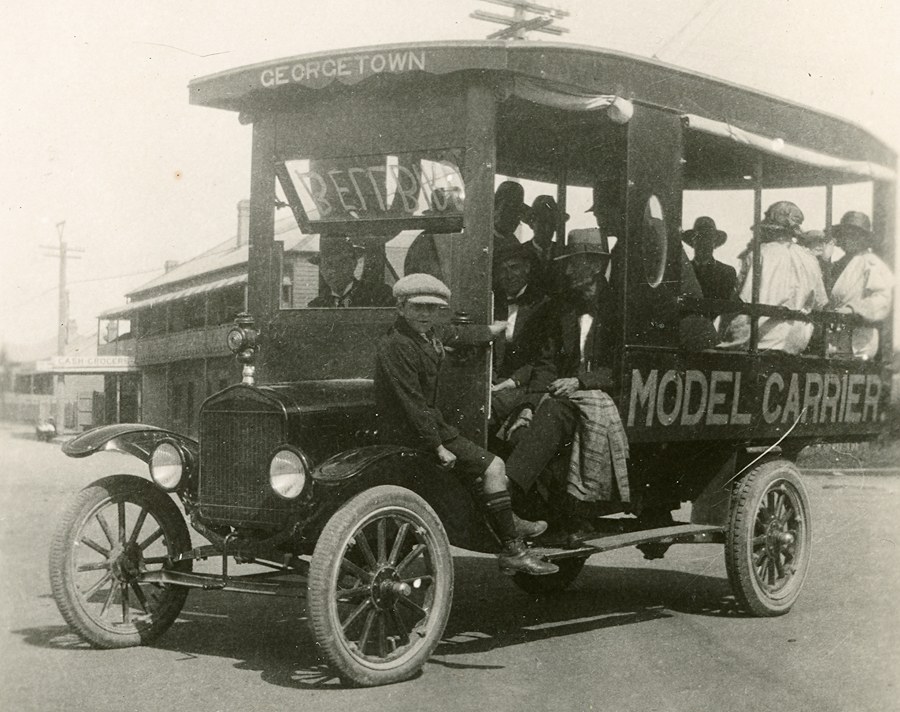
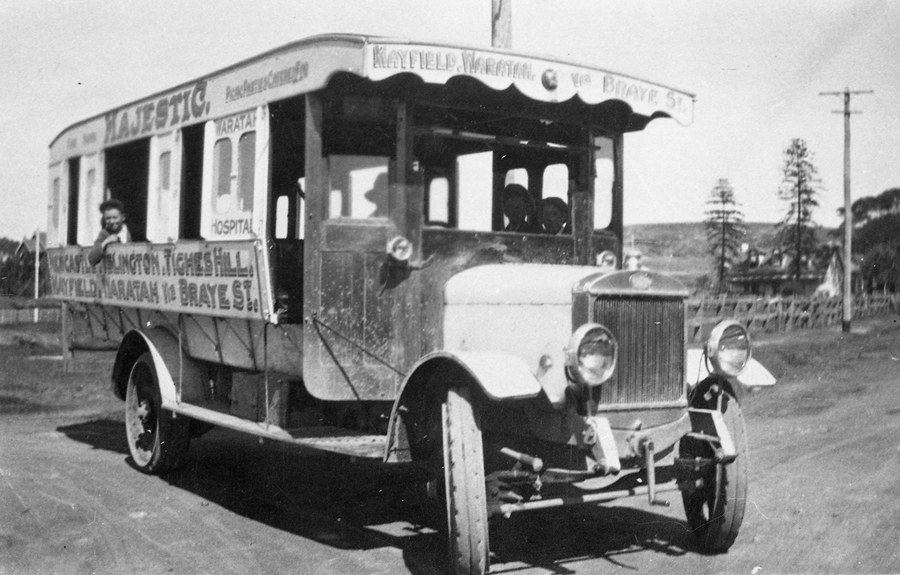
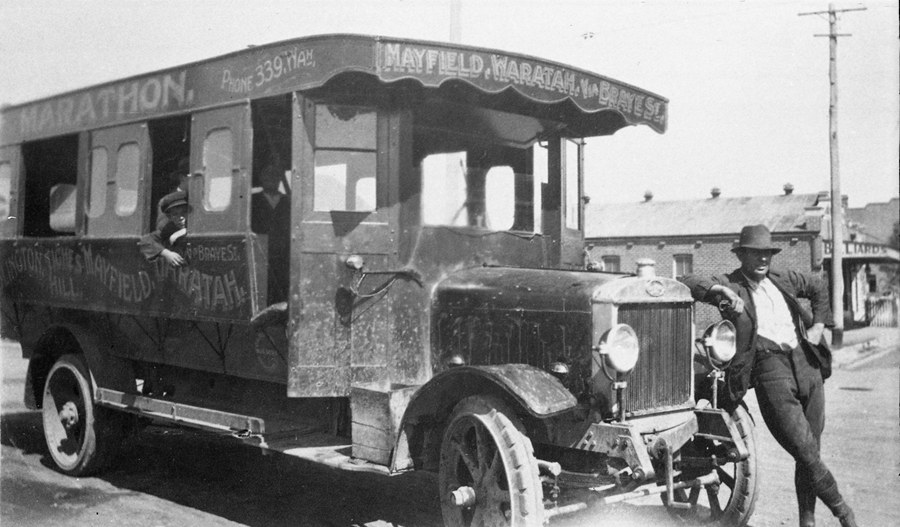
Varied names were given to early private buses. It would be a rare sight to see such a name painted on the side of a bus body, however most of the systems have fleet numbers and even today drivers have affectionate names for their vehicles. Early buses were mostly named after ships and racehorses. Some of the early buses (with owners names in brackets) being :
The Adelaide, Canberra, Newcastle (Aarson); The Endeavour (Brewsters); The Jazz and Britannic (Coulin Bros); The Sunbeam (Stan Davidson); Salitros and Adamstown (George Downie); The Wattle (Charlie Ede); Laddie Blue (Artie Greenwood); The Red Cardinal (A.J. Greenwood); Westralia and Westralia No.2 (Hall and Coslett); The Arcadia (E. Harris); The Mayfair (Stan Hughes); The Irresistible (Clarry Lang); The Excelsior No l and No 2; (Leatherby and Fallows); The Greenstead and Boronia (Makin and Son); The Central, Lord Zell and Lady Zell (W.T. McIntyre); The Marathon (H. Pearce); The Minerva No 1 and No.2 (Ramsay and Sealby); The Victory (Riley) The McQuarie (Robertson); The Hunter (Rooney); The Curlew (A. Rosah); The Olive May (Sherrin) and the Maryvllle (later Wooley) and The Excelsior and Gloaming (Stevenson); The Aussie (Mrs Webb); The Cooee and Kaiai (J Wiggens); The Lily White renamed Aquitania (Jock Yates);
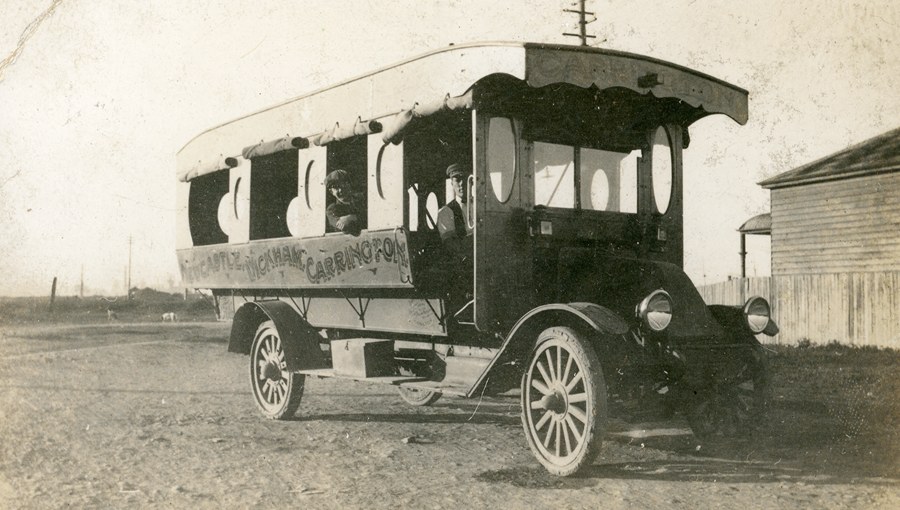
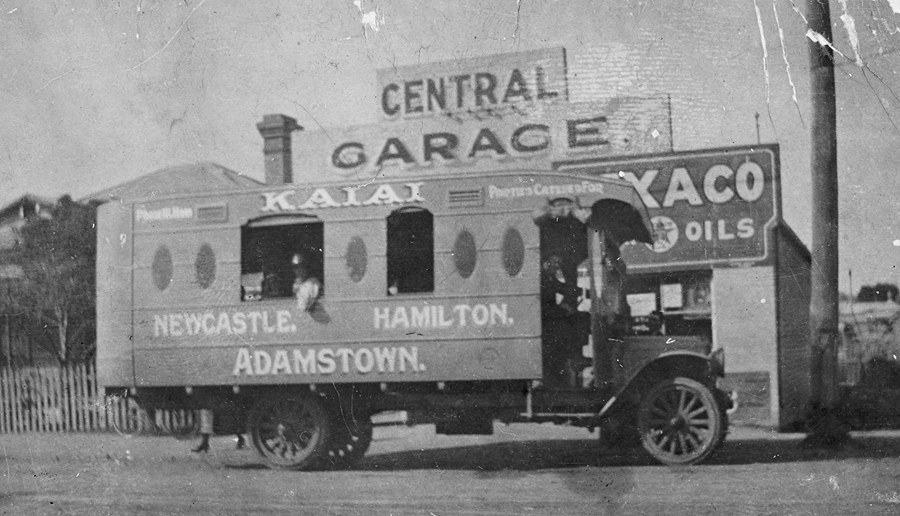
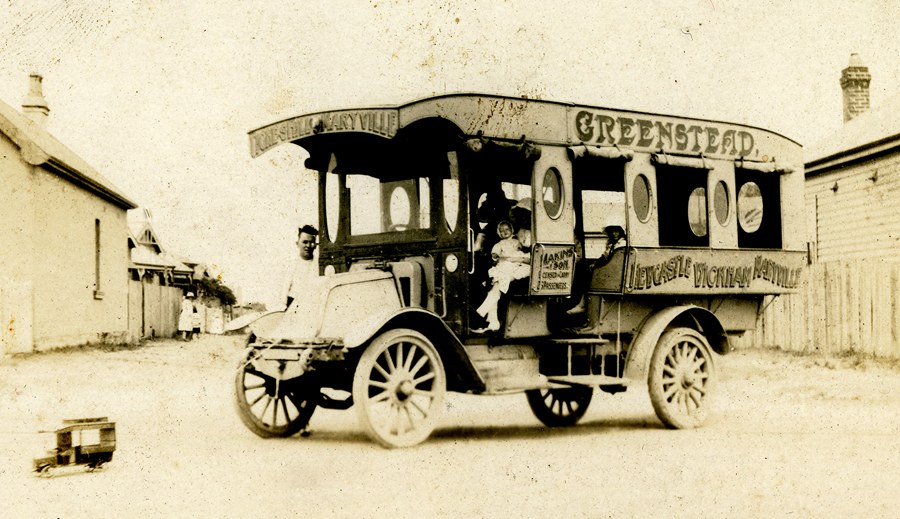
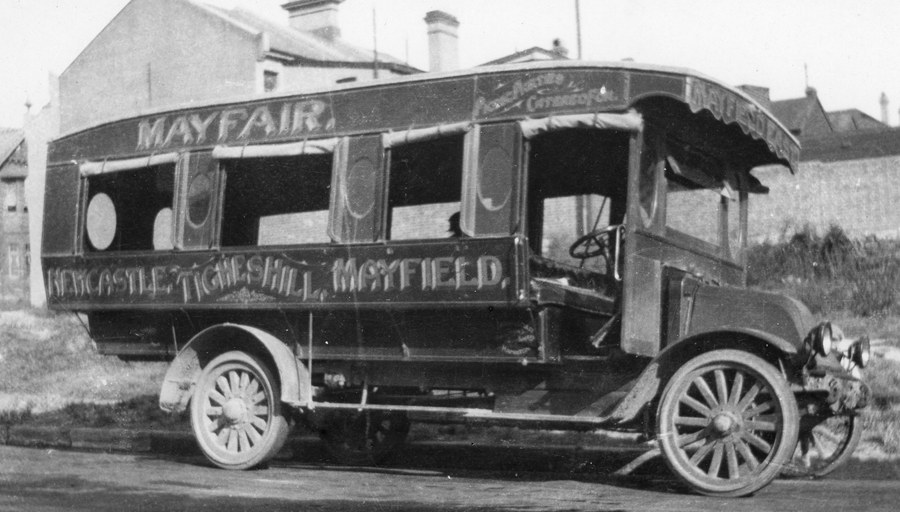
Other operators being (with names of routes operated in brackets): Ted Ball (Mayfield East); Brewsters (New Lambton); Ernie Buck (Queens Road, New Lambton) George Burnley (North Lambton via Georgetown); Carthew Bros (Mayfleld); Hickey (Mackie Ave New Lambton); Howarths (Regent St New Lambton); Perc. Leighton (Glebe); Melville (lngall, Crebert, Woodstock and Tourle Streets, Mayfield); Eric Murray (Wallsend to Swansea); Howe & Roach (New Lambton); Russell (Wallsend to BHP and Steelworks); W.E. Shepherd (Adamstown via Hamilton); Spencer Bros (Maryville via Wickham); Harry Sutton (Dudley Motor Service); Wilson (Minmi); Emelin Bros (Swansea).
Feighans, Martin, Jack Oliver, O’Keefe Bros, O’Keefe and Cleaves, R. Leighton and C. O’Keefe; Nightingale, Peg and O’Keefe; Scribner; Slieshman; Taylor Wade and Messrs T. and J. Wrightson were other operators.
Owing to the large number of buses operating the proprietors formed the Newcastle Motor Omnibus Association on May 16,1922, and held their meetings in Mitcheson’s cafe, Telford Street, Newcastle. Previous meetings were held in different owners’ buses.
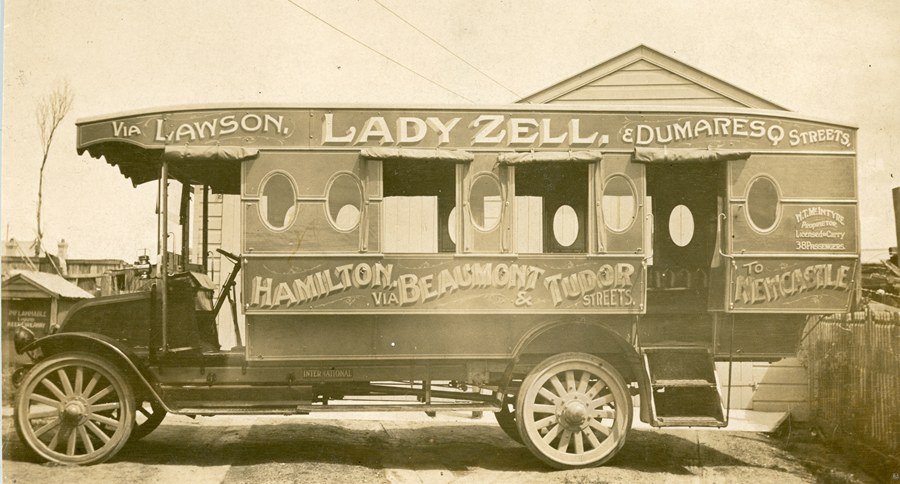
At one time there were 53 buses operating in the steam tram period but with the advent of the electric trams this number was greatly reduced. On September 30, 1946, there were 65 private buses operating but these included outlying systems such as Tea Gardens (A. Sard) and Bulahdelah (White and Leary), Toronto and Swansea etc.
Routes and operators frequently changed amongst themselves and a bus could have up to a half dozen owners during its life.
Mr Aarson operated the Glebe route with the Canberra, Adelaide and Newcastle but later transferred his interests to Cardiff, operating mostly with a fleet of Whites and during Civic Week in 1929 gained first prize with his decorated bus (reg. no 194-624).
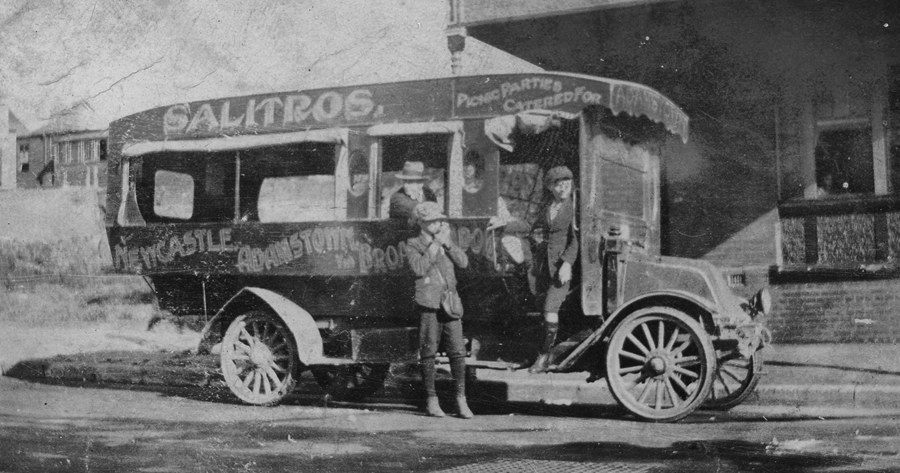
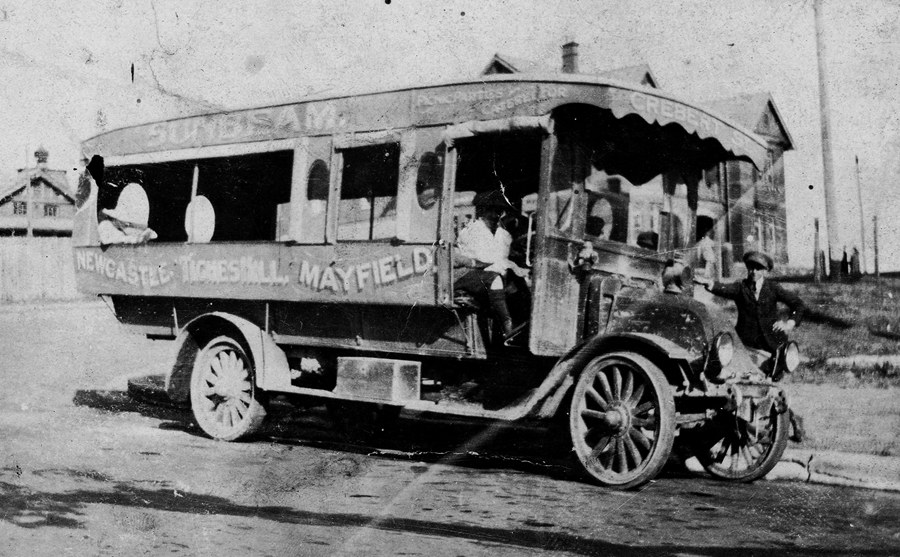
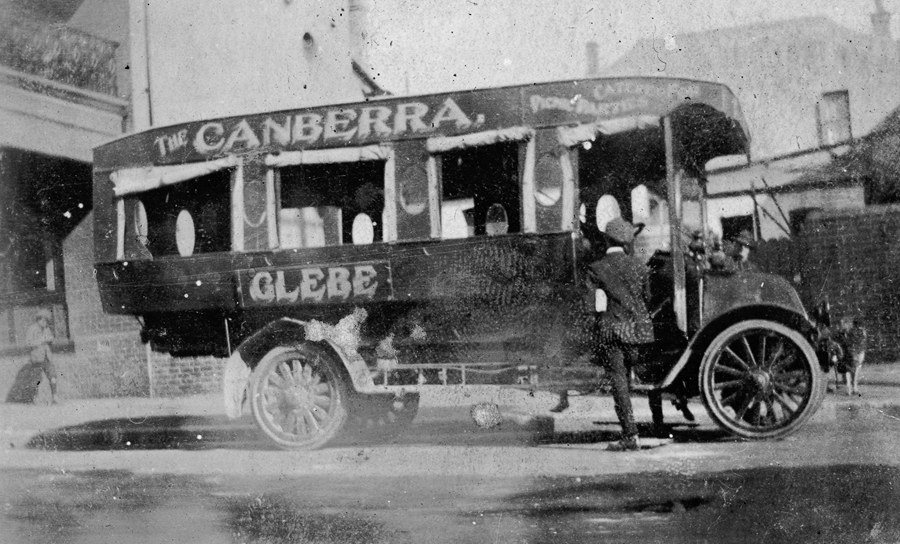
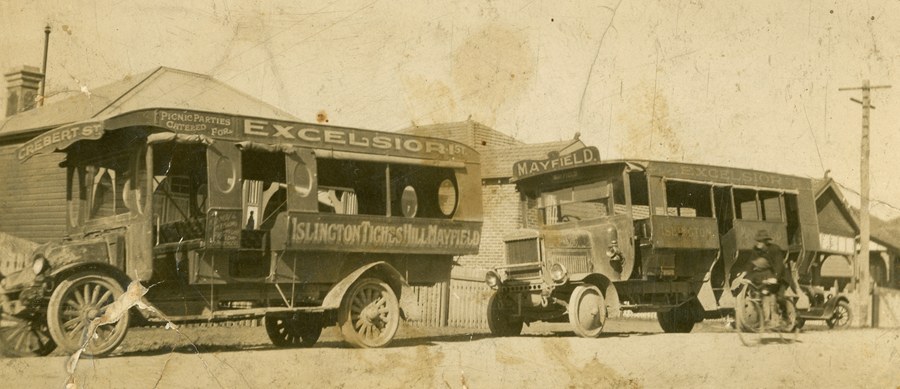
The late Ernie Buck who operated Route 18 (New Lambton) was killed in an aeroplane accident.
George Burnley, operating with a Brockway and an International bus to North Lambton, via Newtown and Georgetown, which later was to become the government route 220.
Coulin Brothers’ Britannic bus body had experimental door openings on the off side but owing to the dangerous alighting on the wrong side, these doorways were closed in. The Guy-motored vehicle operated to Adamstown and had its radiator core painted red with a large white spot thus depicting the destination sign of the tram also operating on this route.
Brian Ivans operated the “Reindeer Bus Line” (Routes 15 and 18), Broadmeadow to New Lambton and New Lambton – Bar Beach respectively, and is still operating buses at Taree, NSW.
Arthur, Charlie Hancock and Ted Hemmings commenced operating in 1922 with an International charabanc (Newcastle – Swansea – Catherine Hill Bay). Later Charlie Hancock operated on his own and became Hancocks Motor and Tourist Service, and the 1936 Guilford bus of his fleet was the most modern design of that period.
Services ran to Warners Bay, Speers Point and Raymond Terrace.
Hickey, Clack and Veal operated buses to Dudley. One of the vehicles was called The Dudley. Its body was made of Queensland maple, varnished and polished but not painted, this vehicle was to be destroyed by fire on the Dudley road. One of their vehicles was an International Charabanc having front wheel pneumatic tyres whilst the rear ones were of solid rubber.
Johns and Skinner operated on the Carrington route with the Etive and Encre. The Newcastle Morning Herald complimented these operators on the efficient manner in which the travelling public were considered when a new 2.5 ton Republic chassis was purchased from local agents Young and Green, with a body built by the noted northern body builders Brown and Scully.
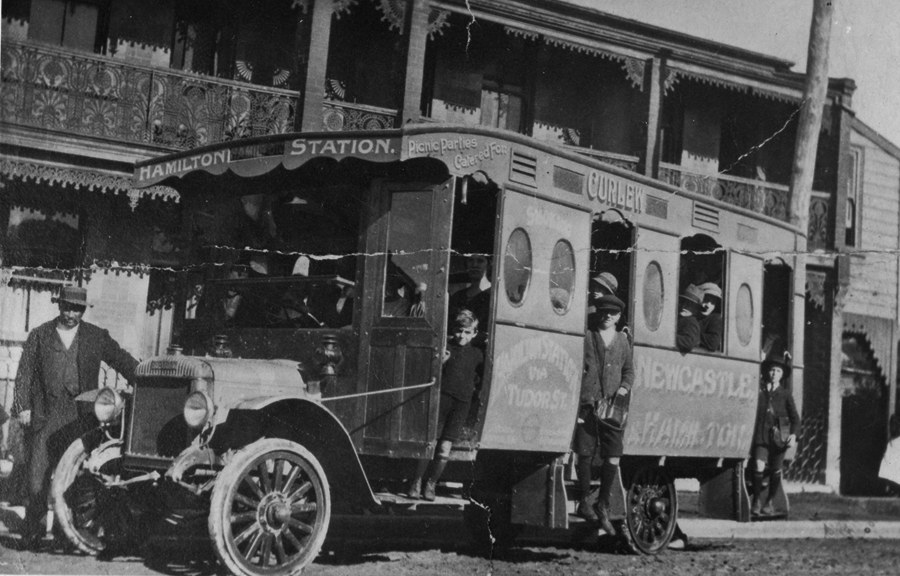
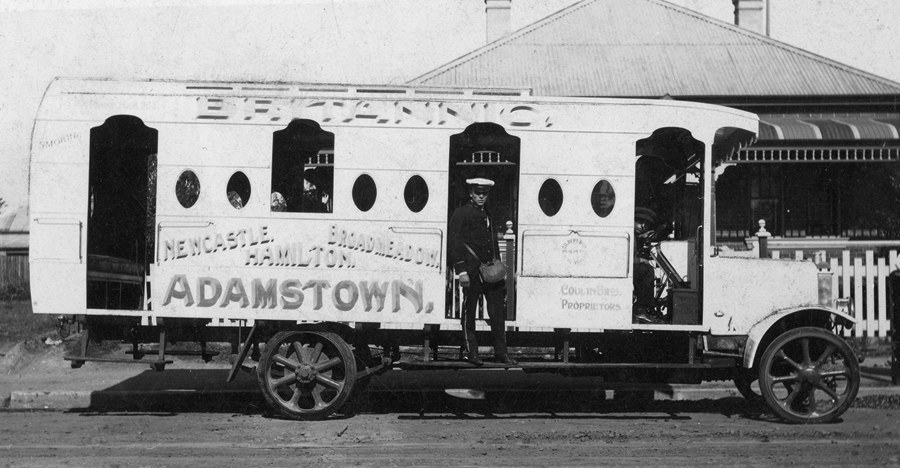
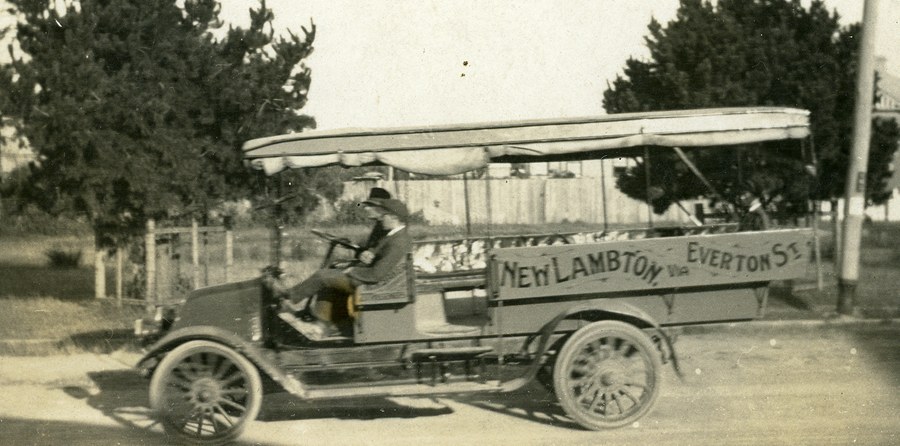
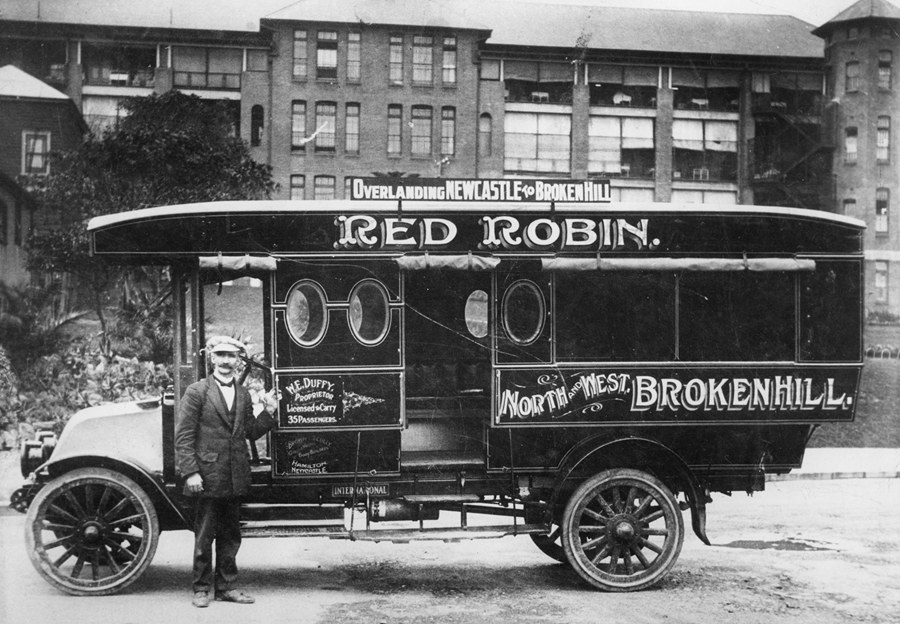
Brown and Scully built two other buses, the Red Robin and the Cock Robin, for Mr W.E. Duffy, who operated the first town service Broken Hill in August 1922 with the former bus. Mr Duffy drove Red Robin overland, travelling 710 miles in 61 hours via Maitland, Singleton, Muswellbrook, Denman, Merriwa, Mudgee, Dubbo, Nyngan to Cobar, thence in long treks to Wilcannia and on to Broken Hill. The seats were upholstered in leather, the bus had electric light throughout and was finished off in Pullman style with a seating capacity of 33 passengers.
An unfortunate accident marred the service of this bus in Tudor Street, Hamilton, during showtime traffic. Mr Johns was killed whilst he was leaning out of the bus listening for a noise caused by the vehicle when a tram passed by. All buses operating at the time formed the funeral cortege and travelled to Sandgate carrying the mourners and Mr Harry Pearce (bus proprietor) spoke at the cemetery.
E.P. Hunt’s bus, The Mons King, was destroyed by fire where the Hamilton Fire Station now stands.
Most owners started off with a standard type vehicle mainly a 30CWT International chassis having solid rubber tyres advancing to pneumatic-tyred vehicles.
Kents Removalists of Waratah were prominent in these periods operating Model T Fords. Whilst not in use for carrying work, seats would be placed inside the bodies and then used for passenger carrying, later modernising with tourist-type coaches and eventually centering on the carrying business.
Fred Styles had a service in the Maitland area operating the “Sir Maitland”, “Beau Bee” and “Eurythmic”, later transferring his interests to New Lambton area and later operated a Vulcan bus.
W.H. Taylor converted the old Sunbeam (ex Stan Davidson) to a carrying truck but fitted seats whilst operating the steelworks service.
Merv and Ron Baker operated a New Lambton service with “The Marvel”, and “The Triumph” – a bus body built by themselves in their backyard. Later Merv pioneered the Toronto – Kilaben Bay – Carey Bay service whilst Ron today manages the Wonderland buses of Port Stephens Bus Co which add colour to our drab city whilst standing at their Watt Street terminus.
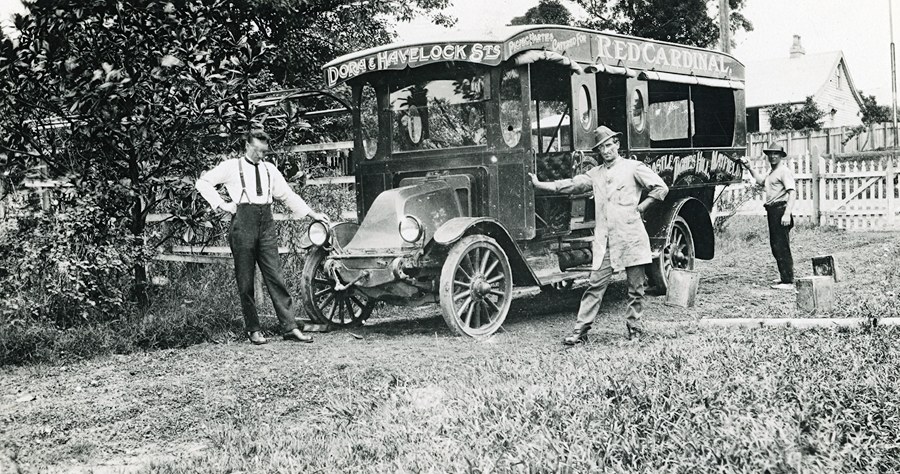
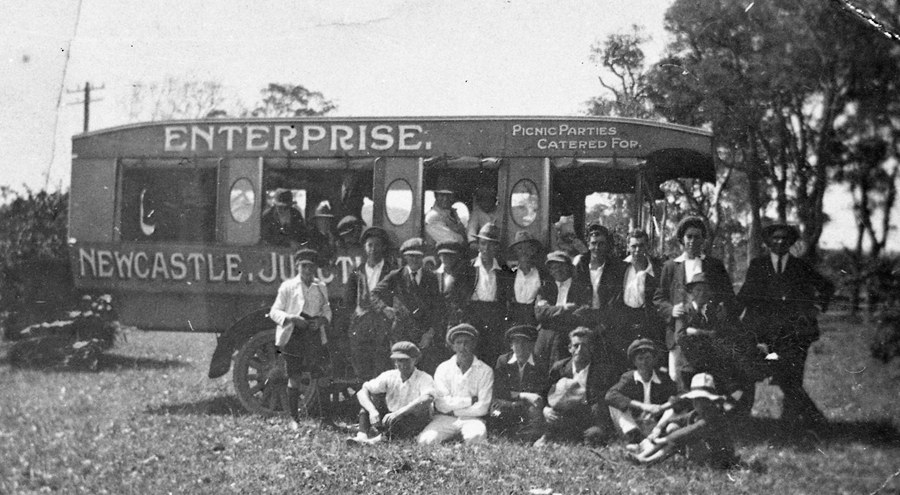
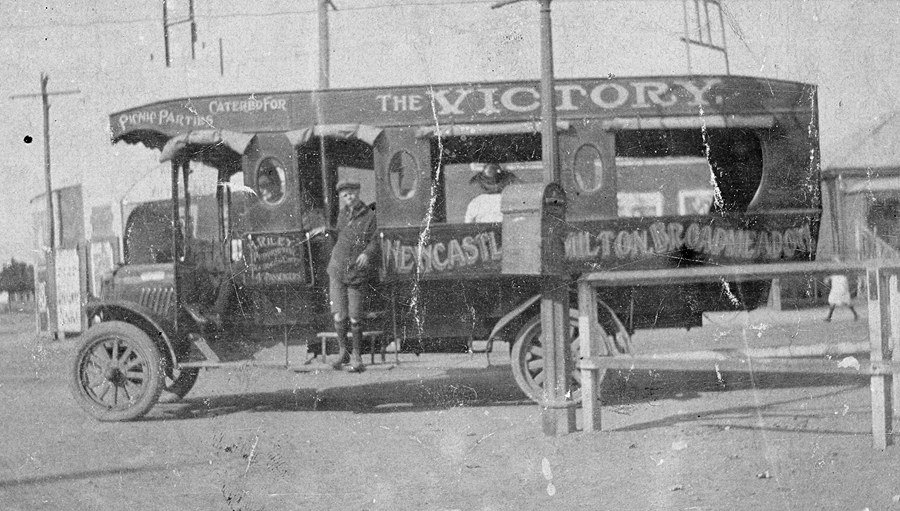
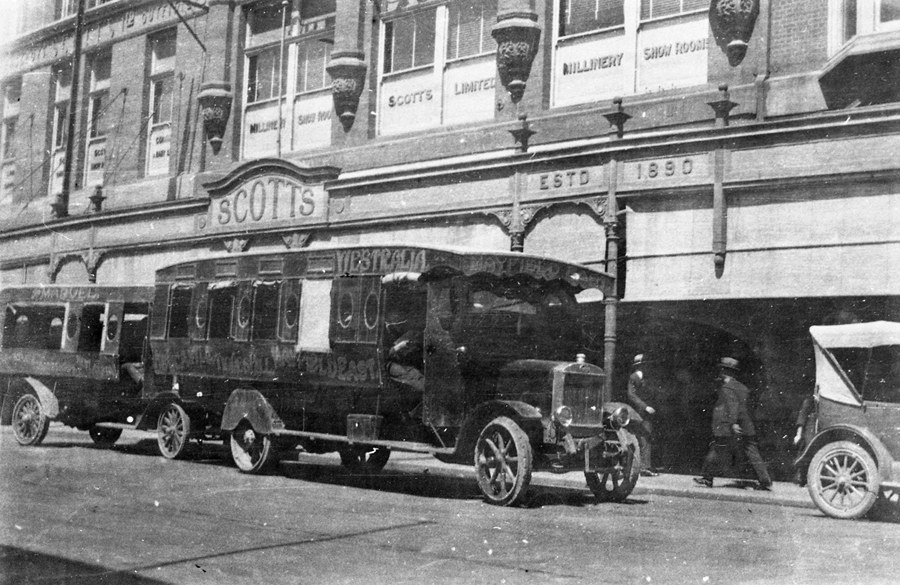
The late Amos Fogg was a name well-known in Newcastle private bus operation, though he commenced his career in the Cessnock area, and at one time had controlling interests in most bus lines and a familiar phrase “Fogg over Newcastle” came into being.
The private operators of today are amongst the early 1920s pioneers. Mrs. E.H. Chapman and Allomes manage the services their late husbands commenced and Allomes recently added the latest type of coach to their fleet.
Stan Chapman’s black and white buses operated Route 14 and catered for employees at Lysaghts and Stewarts and Lloyds and operated dog coursing buses to Cessnock and at one time ran “The Big Blue” from Newcastle to New Lambton West.
Stockton Bus Service now operated by Sid Fogg (brother to Amos) is an isolated system but covers the northern parts to Medowie and Willamtown and operates services from the Stockton ferries.
The Blue and White private services to Bar Beach and Merewether Beaches are a familiar sight in Beaumont Street, Hamilton. Originally operated by Mensons but now operated by Messrs Prince and Lambert respectively.
In 1950 Len Scholes and George Wolfe started the Hamilton Motor Service. Upon the death of Mr Wolfe, Len Scholes Motor Service came into being operating Route 15 (Stewarts and Lloyds and Rylands Industrial Service); Wyong-Gosford horse races specials and Route 5 (The Hill service) which a Mr Howley will be remembered operating with Packard cars and during the war years. A familiar sight were these vehicles with their large gas bags billowing as they travelled their route.
Outlying parts such as Raymond Terrace and Cardiff are serviced by Fogg’s Motor Service. The service from Cardiff via South Wallsend, Wallsend, Shortland, Sandgate and Mayfield gives a valuable interconnection between the suburbs as well as assisting residents to reach Cardiff and Mayfield except by round-about methods and Birmingham Gardens is made more accessible, also meeting the requirements of the Wallsend Hospital.
Government buses travelling in another direction service Cardiff also other outlying suburbs such as Swansea where a local service Presland’s Motor Service caters for the surrounding districts with a modern bus fleet.
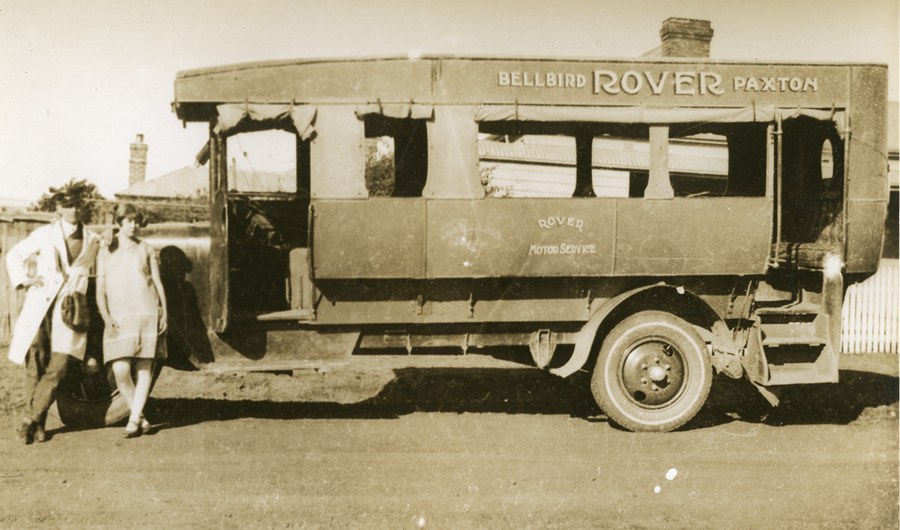
Interstate services are carried out by Pioneer coaches operating from Jayes Travel Service at Scott Street, Newcastle and other Interstate coaches call at this terminus. The Central Coast Coaches operate tours throughout NSW and charter work to as far afield as Tasmania and operated in the Gosford – Wyong – The Entrance areas also utilises Jayes as a terminal point,
White and Leary Bulahdelah Bus Service has its terminus in Watt Street along with the Gloucester service operated by Fogg’s where they await the trains arriving at Newcastle station and give direct road services to these centres and other places en route.
Cessnock and Newcastle were once connected with express bus services when Amos Fogg operated a Studebaker coach named “The Painted Lady” and Rover Motors (Cessnock) ran a coach named “The Cessnock Limited” catering for Maitland and Kurri Kurri along with a Faegol coach called “The Flying Scotsman”.
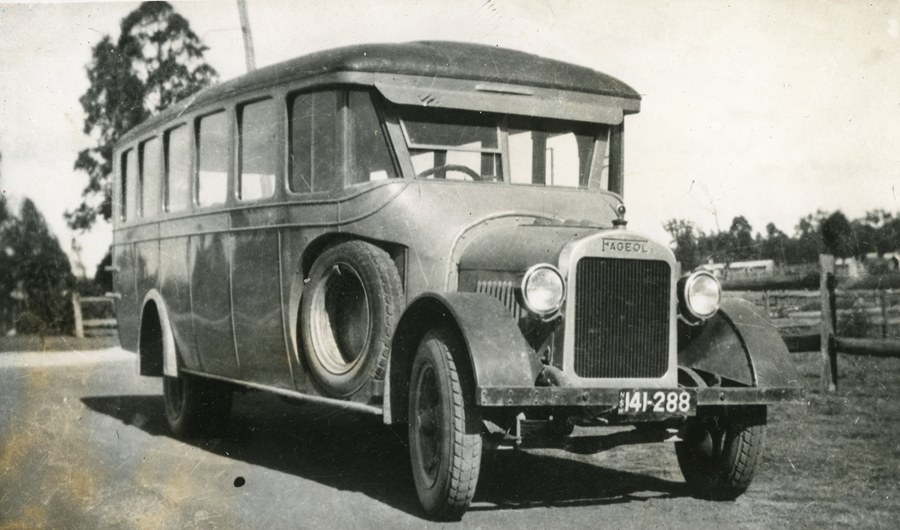
STEELWORKS
Past and present employees at the BHP Steelworks, Port Waratah, have experienced all modes of conveyances to transport them to and from work over the period of years ranging from the open type bodies fitted to T model Fords to the present modern motor bus. Steam and electric trams also carried employees. Early days parking at the steelworks could be likened to a rubbish dump as photos of this era show buses parked at all sorts of angles.
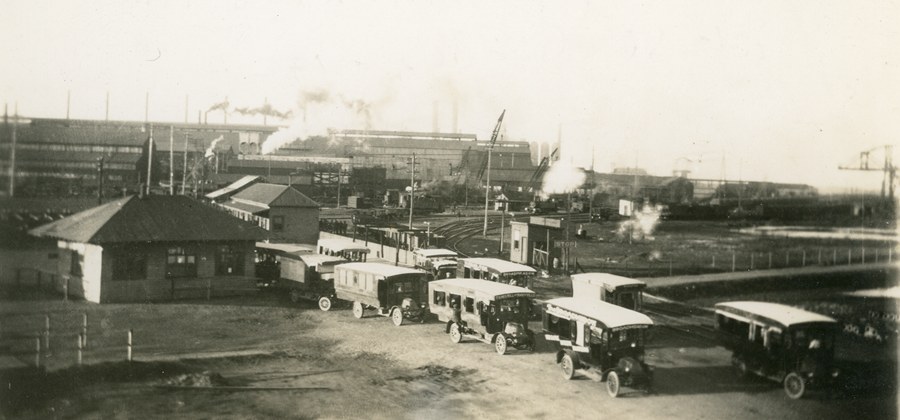
Today however the buses have to line up orderly in their respective spaces allotted then and a colourful view can be experienced just prior to the 4pm knock-off whistle, what with the Oodnadatta Beige and Beauvllle Blue semitrailer and double-deckers of the Georgetown Bus Service, Johnson’s Black and white buses from Young Wallsend, the Deluxe Sky Blue and Bergers Chocolate (Linsley Bros) double-deckers from Wallsend, the Highway Grey and Cameo Beige of Allomes single deckers and the Red buses from as far as Cessnock of Rover Motors fleet, Toronto Bus Service and Chapman’s with their various coloured roofs. These buses also cater for Stewarts and Lloyds, Rylands and Commonwealth Steel works by picking up outside the works themselves.


